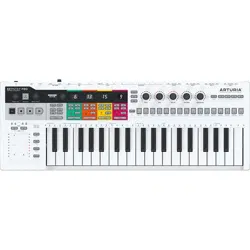Loading ...
Loading ...
Loading ...

Press the Play/Pause/Restart button again to pause the sequence; press it once more to
resume playback from where you stopped.
Making Global changes to a sequence
At this point, you can make quick global edits to the pattern you've recorded.
Holding 'Shift' and turning one of the five encoders will apply a relative offset to all the steps
contained in the sequence for a parameter. The offset can be positive or negative. If for
example you hold 'Shift' and turn the Velocity encoder to the right, the value you dial in will
be added to the velocity value of all the steps in the sequence. Turning the encoder to the left
will subtract values. The KeyStep Pro will display the amount of added/subtracted velocity.
Global offset has no effect on the pitches in the drum track, but it will affect Gate, Velocity,
Time Shift and Randomness.
♪: To turn off stuck notes (notes that continue to play after stopping the sequencer) press the Stop
button once more.
To start something new, press Clr Ptn (Clear Pattern) and create a new sequence. This will
clear all parameters of the Pattern.
♪: The previous Pattern – the one you erased – is still in memory. Hold down 'Shift' and press Exit/
Undo to restore it. The Exit/Undo button will blink whenever there is something present in the undo
buffer.
5.3.2.2. Step Record
In Step Record mode, the KeyStep Pro can record and play back music data. Originally
popular in the 1960s and '70s, step sequencers have become popular again due to the
increased interest in modular synthesizers.
A step sequencer is usually
monophonic
, meaning that it will only output one note at a time.
The KeyStep Pro sequencer, however, is capable of stacking up to 16 notes per sequence
step.
Step Record mode is the preferred way to quickly record sequences. Unlike Quick Record
(described above), where you have to manually select the steps you want to fill, in Step
Record mode you use the keys of the keyboard to step through the Pattern, advancing
automatically to the next step when you lift your finger from the keyboard. Press RECORD
to activate Step Record mode. The KeyStep Pro will jump to the first step of the Pattern and
wait for you to enter a note or notes. Start playing and notice how the steps fill. At the end
of the Pattern, the KeyStep Pro will loop back to the beginning and overwrite the notes you
played before.
Step Record has one other feature: you can 'backpedal' to a previous step and overwrite
it. To give an example: you've pressed Record and have filled six steps by entering chords
and lifting your fingers from the keyboard to advance a step. You can now backpedal by
pressing step four and restart recording from there. When Overdub is OFF, the new notes
you play will replace the notes you've recorded in steps 4, 5 and 6.
80 Arturia - User Manual Keystep Pro - Making Tracks
Loading ...
Loading ...
Loading ...
